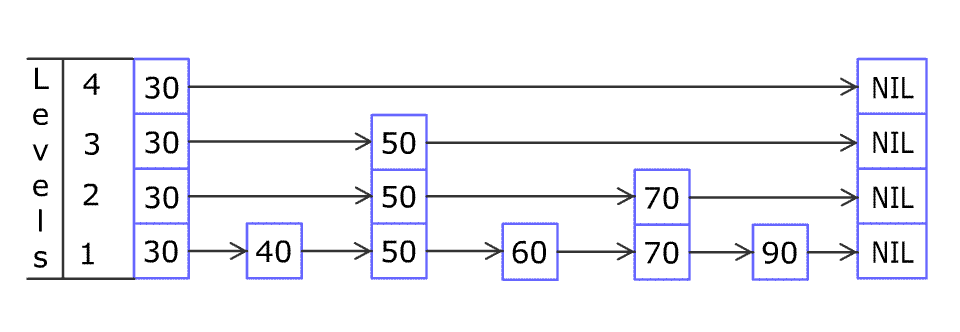Problem
Design a Skiplist without using any built-in libraries.
A skiplist is a data structure that takes O(log(n)) time to add, erase and search. Comparing with treap and red-black tree which has the same function and performance, the code length of Skiplist can be comparatively short and the idea behind Skiplists is just simple linked lists.
For example, we have a Skiplist containing [30,40,50,60,70,90] and we want to add 80 and 45 into it. The Skiplist works this way:

Artyom Kalinin [CC BY-SA 3.0], via Wikimedia Commons
You can see there are many layers in the Skiplist. Each layer is a sorted linked list. With the help of the top layers, add, erase and search can be faster than O(n). It can be proven that the average time complexity for each operation is O(log(n)) and space complexity is O(n).
See more about Skiplist: https://en.wikipedia.org/wiki/Skip_list
Implement the Skiplist class:
Skiplist()Initializes the object of the skiplist.bool search(int target)Returnstrueif the integertargetexists in the Skiplist orfalseotherwise.void add(int num)Inserts the valuenuminto the SkipList.bool erase(int num)Removes the valuenumfrom the Skiplist and returnstrue. Ifnumdoes not exist in the Skiplist, do nothing and returnfalse. If there exist multiplenumvalues, removing any one of them is fine.
Note that duplicates may exist in the Skiplist, your code needs to handle this situation.
https://leetcode.com/problems/design-skiplist/
Example 1:
Input
["Skiplist", "add", "add", "add", "search", "add", "search", "erase", "erase", "search"]
[[], [1], [2], [3], [0], [4], [1], [0], [1], [1]]
Output
[null, null, null, null, false, null, true, false, true, false]Explanation
2
3
4
5
6
7
8
9
10
skiplist.add(1);
skiplist.add(2);
skiplist.add(3);
skiplist.search(0); // return False
skiplist.add(4);
skiplist.search(1); // return True
skiplist.erase(0); // return False, 0 is not in skiplist.
skiplist.erase(1); // return True
skiplist.search(1); // return False, 1 has already been erased.
Constraints:
0 <= num, target <= 2 * 10⁴- At most
5 * 10⁴calls will be made tosearch,add, anderase.
Test Cases
1 | class Skiplist: |
1 | import pytest |
Thoughts
就像处理普通的链表那样,加一个虚拟的 head 节点可以简化边界处理。
另外跳表在插入的时候,已经在某一层插入了,是否需要在上一层也加入,可以引入随机判断。
PS: 加了个
format方法把当前跳板格式化成字符串。如
2
3
4
HEAD----->40------------->70->80----->NIL
HEAD->30->40--------->60->70->80->90->NIL
HEAD->30->40->45->50->60->70->80->90->NIL
Code
1 | from random import randrange |